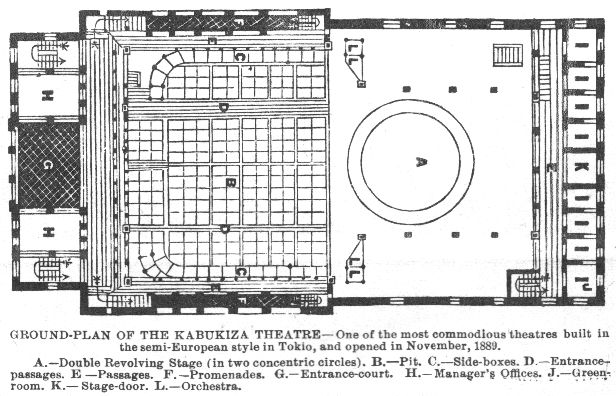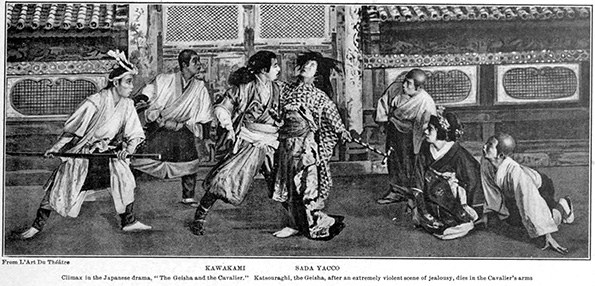 |
| From L'Art Du
Théatre
KAWAKAMI SADA YACCO Climax in the Japanese drama, "The Geisha and the Cavalier." Katsouraghi, the Geisha, after an extremely violent scene of jealousy, dies in the Cavalier's arms. |
Theatres and Theatre-Going in Japan
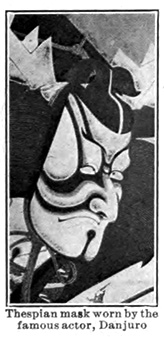 MODERN Japan, despite its ready adoption
of Western manners, is in things theatrical still faithful to the ancient feudal
days, and the sanguinary, interminable dramas written many centuries ago are
still the chief attractions in the Mikado's theatres. It is true that within the
last few years—in fact, since the triumphant European and American tours of
those distinguished Japanese players, Sada Yacco and Oto Kawakami—the old
school drama has to some extent lost ground, and quite recently performances of
Shakespeare's "Othello" and "Hamlet," and Daudet's "Sappho" have been received
with favor by Tokio audiences.
MODERN Japan, despite its ready adoption
of Western manners, is in things theatrical still faithful to the ancient feudal
days, and the sanguinary, interminable dramas written many centuries ago are
still the chief attractions in the Mikado's theatres. It is true that within the
last few years—in fact, since the triumphant European and American tours of
those distinguished Japanese players, Sada Yacco and Oto Kawakami—the old
school drama has to some extent lost ground, and quite recently performances of
Shakespeare's "Othello" and "Hamlet," and Daudet's "Sappho" have been received
with favor by Tokio audiences.
The explanation of this curious survival of the old form of play, at a time when all Japan is eagerly imitating the foreigner, is undoubtedly to be found in the peculiar customs of the country. The progressive Japanese finds it easier to change his mode of dress than to reform habits bred in the bone. The old plays, lasting, as they formerly did, from early morning until nearly midnight, just suited the Japanese play-goer, who, when he does go to the theatre, makes an all-day affair of it. Indeed, theatre-going in Japan is a very serious matter, like an ocean voyage or long railroad journey with the American, and not to be entered upon lightly or without due preparation. Some ten or twelve years ago the Japanese police limited the duration of a dramatic performance to eight hours, and more recently Sada Yacco and Oto Kawakami, who learned a good deal in their foreign travels, introduced the comparatively short evening performance of three or four hours, an innovation which was at once welcomed by the better class of people. But the new arrangement found little favor with the general public, whose honorable traditions it rudely upset, and particular indignation was aroused in the bosom of the Japanese Matinee Girl—fully as important a person in Japan as in America—who loves to sit in the theatre as long as possible and weep over the play. For, to the gentle mousmé, the theatre is essentially the place for weeping. Japanese girls are extremely sentimental, and a play without borrowing situations would not appeal to them in the least. The musical comedy—as presented in America and England—is quite unknown in Japan, for which we Japanese should perhaps be devoutly thankful. Recently, attempts have been made to introduce grand opera in the Flowery Kingdom, but only with indifferent success.

From a native print. Scene in a
Japanese theatre during the performance of a play, showing the spectators stowed away in their little compartments.
Three kinds of plays are popular in Japan—the religious dramas, mingled with
farce, the domestic dramas of everyday life and love, and the historic dramas,
bristling with blood and suicides, which are liked best of all. The religious
drama dates from the ninth century, when the country was visited by a terrible
earthquake. Flames issued from the ground, and the priests, to propitiate the
gods, executed [<167] a dance near the spot. The flames at once stopped, and in
recognition of the miracle every performance of a religions play to this day is
preceded by the Sambash or rhythmic dance executed by an old priest and
accompanied by a plaintive chorus.

The
programme for one day usually consists of three different pieces. The first is
invariably an historical play, dealing with some noble family—its quarrels and
misfortunes; and the third is a love story. The piece between these two is
called a "Middle Curtain," being a classic with a wonderful display of dress and
dancing.
At the end of each act the curtain is drawn to slowly in order to let the spectators remain as long as possible under the spell of the situation, which is continued, but at the end of the intermission it falls abruptly in order to dazzle the public suddenly with the splendor of the picture. These drop curtains are covered with enormous characters and in striking colors: black on orange, white on blue, violet on red. The same curtain is not used during the whole performance. It is the custom to make the present of a curtain to a favorite actor. Thus, when speaking of a popular performer, you say, "He has so many curtains!"
 |
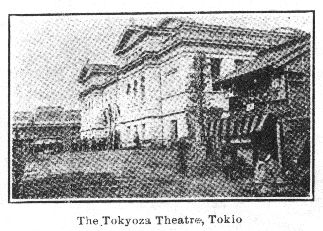 |
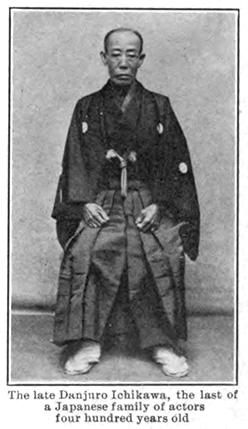 There are several fine theatres in Tokio, the most
important being the Kabukiza, the Meijiza, and the Tokyoza. They are
imposing edifices constructed of stone in semi-European style, but the
interior is arranged in the old Japanese manner which has been in vogue
since the birth of the native drama. You do not purchase your ticket at the
box-office, as in other countries, but at the neighboring tea-house, where
arrangements are also made to keep your party supplied with refreshments
during the long hours the play lasts. Over the main entrance of the theatre
is a large framed poster depicting scenes in the play then being performed.
Entering the theatre you see a large square floor partitioned off into tiny
compartments or boxes, giving the effect of a gigantic checker board. The
boxes are three feet square by about three feet high, and they each
accommodate four or five persons. On either side of the parterre, and almost
level with the top of the boxes, is a plank which runs from the entrance
down to the stage. This is called The Flower Path, its sides in olden times
having been decorated with flowers. The Japanese stage is always supposed to
face the south, but the origin of this tradition has been lost in time.
There are two or three rows of boxes outside the flower path, raised
slightly higher than the parterre, and the auditorium is closed on both
sides by other boxes. On the second floor, facing the stage, are similar
boxes, rising one behind the other and closed in at the back by a long,
barred window. On the far side of this window is a narrow passageway or
"chicken coop" to which are admitted those theatre-goers who on payment of
two cents can see a single act. These form a special public, and a most
important one to the Japanese manager. They are theatre enthusiasts who
cannot let a day go by without seeing at least some part of the play. They
are known as the success makers. They are equally well known as the noise
makers! The din they make whenever one of their favorite actors makes his
entrance is appalling. They shout Naritaya! (the stage name of the
late celebrated Danjuro). The success or failure of a performance depends on
the amount of noise they succeed in making, for in Japan very little
attention is paid to what the dramatic critics have to say. Happy land!
There are several fine theatres in Tokio, the most
important being the Kabukiza, the Meijiza, and the Tokyoza. They are
imposing edifices constructed of stone in semi-European style, but the
interior is arranged in the old Japanese manner which has been in vogue
since the birth of the native drama. You do not purchase your ticket at the
box-office, as in other countries, but at the neighboring tea-house, where
arrangements are also made to keep your party supplied with refreshments
during the long hours the play lasts. Over the main entrance of the theatre
is a large framed poster depicting scenes in the play then being performed.
Entering the theatre you see a large square floor partitioned off into tiny
compartments or boxes, giving the effect of a gigantic checker board. The
boxes are three feet square by about three feet high, and they each
accommodate four or five persons. On either side of the parterre, and almost
level with the top of the boxes, is a plank which runs from the entrance
down to the stage. This is called The Flower Path, its sides in olden times
having been decorated with flowers. The Japanese stage is always supposed to
face the south, but the origin of this tradition has been lost in time.
There are two or three rows of boxes outside the flower path, raised
slightly higher than the parterre, and the auditorium is closed on both
sides by other boxes. On the second floor, facing the stage, are similar
boxes, rising one behind the other and closed in at the back by a long,
barred window. On the far side of this window is a narrow passageway or
"chicken coop" to which are admitted those theatre-goers who on payment of
two cents can see a single act. These form a special public, and a most
important one to the Japanese manager. They are theatre enthusiasts who
cannot let a day go by without seeing at least some part of the play. They
are known as the success makers. They are equally well known as the noise
makers! The din they make whenever one of their favorite actors makes his
entrance is appalling. They shout Naritaya! (the stage name of the
late celebrated Danjuro). The success or failure of a performance depends on
the amount of noise they succeed in making, for in Japan very little
attention is paid to what the dramatic critics have to say. Happy land!
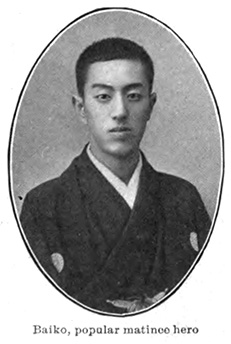 When a Japanese makes up his mind to go to the theatre, he proceeds first by
interesting his neighbors. If he is a married man he consults his wife and
daughters. If he is a bachelor, he gets together a party of friends. The
Japanese women are passionately devoted to the drama. It is usual for a party to
book a box through a tea house connected with the theatre and at the same time
make arrangements for what refreshments they wish served. The Japanese maiden
makes the most elaborate preparations days beforehand, and when the eve of the
eventful day arrives, she has been known to sit up all night so as not to
oversleep herself the next morning. To be at the theatre on time, playgoers must
rise with the sun, and all their meals, including breakfast, are eaten in the
tiny box in the playhouse. It is not an easy task to reach one's seats and once
the family has settled down, nothing but a catastrophe would induce it to leave
its box. They eat in it, smoke in it, nurse babies in it, and put themselves
thoroughly at their ease. In each box there is a small stove, at which they
light the short Japanese pipe, and at their side is the plate of rice and fish
with the traditional chop sticks, and a bottle of saka (rice brandy) and
cups of tea, which are filled as often as emptied. The women chew candy and the
men partake freely of saka as the play goes on. A man who has been
obliged to escort his women relatives is often to be seen fast asleep, for
politeness to women is not seriously discussed in Japan. During the
intermissions, attendants with cakes, confectionery and tea pass up and down the
elevated aisles offering their wares.
When a Japanese makes up his mind to go to the theatre, he proceeds first by
interesting his neighbors. If he is a married man he consults his wife and
daughters. If he is a bachelor, he gets together a party of friends. The
Japanese women are passionately devoted to the drama. It is usual for a party to
book a box through a tea house connected with the theatre and at the same time
make arrangements for what refreshments they wish served. The Japanese maiden
makes the most elaborate preparations days beforehand, and when the eve of the
eventful day arrives, she has been known to sit up all night so as not to
oversleep herself the next morning. To be at the theatre on time, playgoers must
rise with the sun, and all their meals, including breakfast, are eaten in the
tiny box in the playhouse. It is not an easy task to reach one's seats and once
the family has settled down, nothing but a catastrophe would induce it to leave
its box. They eat in it, smoke in it, nurse babies in it, and put themselves
thoroughly at their ease. In each box there is a small stove, at which they
light the short Japanese pipe, and at their side is the plate of rice and fish
with the traditional chop sticks, and a bottle of saka (rice brandy) and
cups of tea, which are filled as often as emptied. The women chew candy and the
men partake freely of saka as the play goes on. A man who has been
obliged to escort his women relatives is often to be seen fast asleep, for
politeness to women is not seriously discussed in Japan. During the
intermissions, attendants with cakes, confectionery and tea pass up and down the
elevated aisles offering their wares.
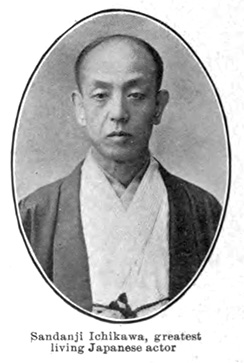 The Japanese thespian is a vastly more important
personage than his professional brother in other countries.
Directly he makes his appearance on the plank leading to the
stage there is a flutter of excitement among the audience,
and fans, purses and tobacco pouches, which have been
specially embroidered for him, are thrown to him. When he
reaches his dressing room lie finds notes containing burning
declarations, and his effigy adorns the tortoise-shell
hair-pin that keeps up the raven tresses of many a dainty mousmé. But the player has a more substantial reward
than mere social success. He is also well paid. The Japanese
theatrical season only lasts four or five weeks, but a good
actor in that time can easily make his $5,000, while the
wretched playwright, a poor, despised creature who in Japan
is looked upon in the light of a theatre attaché, has to be
satisfied with a miserly $100. When a manager wants a new
attraction, he sends for the official playwright and
suggests a subject. The author prepares two or three
scenarios, of which the manager selects the best, and then
the actors also have the right to alter the plan, to suit
themselves.
The Japanese thespian is a vastly more important
personage than his professional brother in other countries.
Directly he makes his appearance on the plank leading to the
stage there is a flutter of excitement among the audience,
and fans, purses and tobacco pouches, which have been
specially embroidered for him, are thrown to him. When he
reaches his dressing room lie finds notes containing burning
declarations, and his effigy adorns the tortoise-shell
hair-pin that keeps up the raven tresses of many a dainty mousmé. But the player has a more substantial reward
than mere social success. He is also well paid. The Japanese
theatrical season only lasts four or five weeks, but a good
actor in that time can easily make his $5,000, while the
wretched playwright, a poor, despised creature who in Japan
is looked upon in the light of a theatre attaché, has to be
satisfied with a miserly $100. When a manager wants a new
attraction, he sends for the official playwright and
suggests a subject. The author prepares two or three
scenarios, of which the manager selects the best, and then
the actors also have the right to alter the plan, to suit
themselves.
Japanese audiences are very loyal to their favorites. What enthusiasm there used to be when the great Danjuro made his appearance! This magnificent actor, the greatest tragedian ever known in Japan, died a few months ago. He left no son, and it is a question who will inherit his name, which has been prominently connected with the Japanese stage for nearly four hundred years! And how delighted we were to watch the late Kikugoro, that wonderful actor whose talented son Baiko is now a matinee idol.
In 1890 the realistic acting of Oto Kawakami and Sada Yacco appeared as a protest against the old school. They were encouraged by the intelligent public, and they put on the stage an adaptation of "Sechu Bai," a political novel. This was the first time that a novel had been dramatized in Japan. With the death of its two greatest actors, Danjuro and Kikugoro, the old school of Japanese drama is declining. The past régime is slowly but surely merging into the new, only following in this, the irresistible progressive movement to which modern Japan owes her present important place among the nations.
